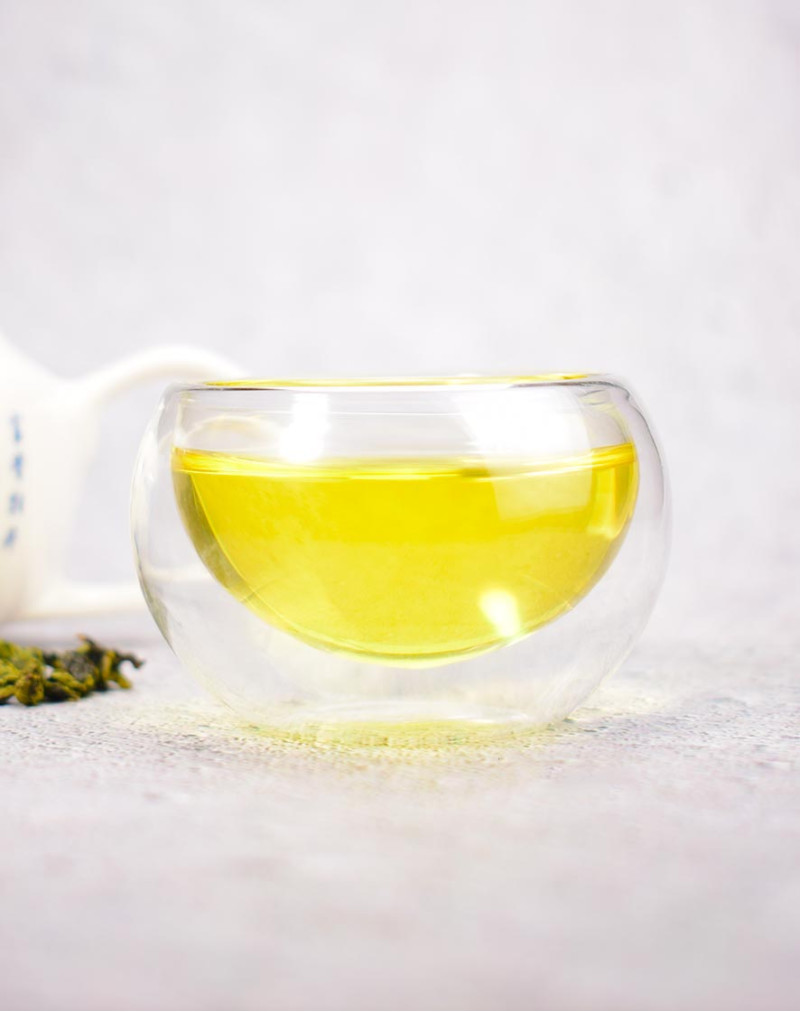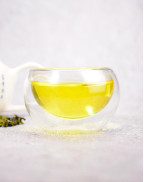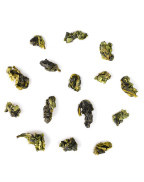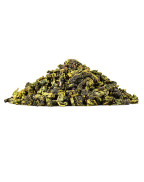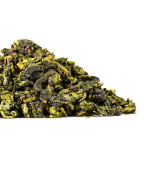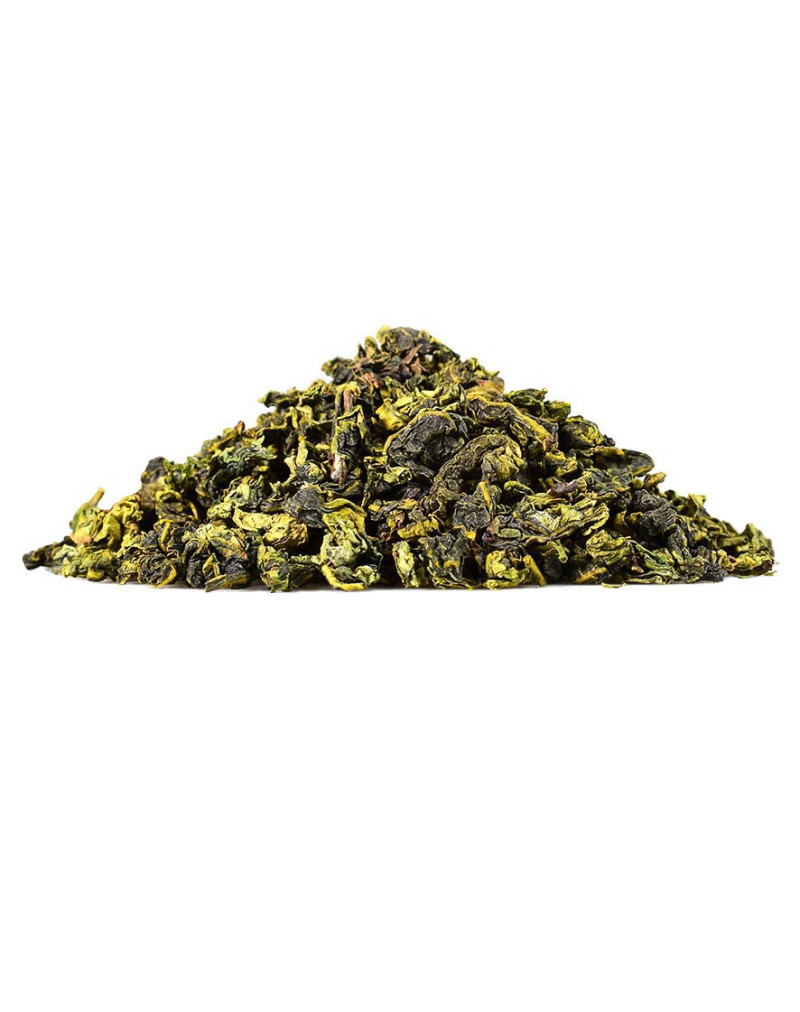Premium Hand-Made Anxi Orchid Fragrance Tie Guan Yin Oolong Tea
- Product Code: simple
- Availability: In Stock
Basic Info
Name: Premium Hand-Made Anxi Orchid Fragrance Tie Guan Yin Oolong Tea
Origin:Hu Tou, Anxi County, Fujian
Tea Garden: Zhang family Gao Shan Tea Garden
Taste & Aroma: Vibrant orchid fragrance, fruity, floral, mellow, fresher, complex aroma,sweet aftertaste, tasting creamy
Item Form: Small pearls or semi-balled with tiny tail
Dry Leaf: Vivid dark green, quite green, rolled into small pearls
Ingredients: Fresh leaves and buds from medium-leaf variety tea bushes
Liquor: Bright golden yellow
Altitude: 1300m above sea
Season: 22th April, 2024
Ingredients: Hand-picked natural tea buds and leaves
Shelf Life: 8 months at room temperature / 18 months with low temperature storage
Storage: Stored in cool, airtight, opaque containers - refrigeration is recommended
Flavor: Unflavored
Maker: Xiaotong Zhang
Caffeine: Medium
Premium Hand-Made Anxi Orchid Fragrance Tie Guan Yin Oolong Tea
The fresh leaves for making this tea were picked from a tea garden 1,300 meters above sea level in the spring of 2022. Far away from the city and has a good ecological environment, the tea garden is located in Anxi County, the birthplace of Tie Guan Yin in China. When brewed, this tea exhibits an vibrant aroma of orchid, while tasting sweet and earthy, with an an appetisting strong aftertaste that lingers for some time. Made with traditional skills, this is a premium and not to be missed high-mountain Anxi lightly fermented oolong tea.
Anxi Orchid Fragrance Tie Guan Yin is a premium oolong tea with a delicate and fragrant orchid aroma that lingers on the palate.The orchid aroma of this tea is a result of the unique processing method.It gives more stress on clearness of tea soup and briskness on mouthfeel.The brewed leaves are vivid green looking like it's just been picked due to low fermentation degree and relatively low baking temperature.You might say it looks like a green tea, but the vibrant fragrance confirms its oolong identity.
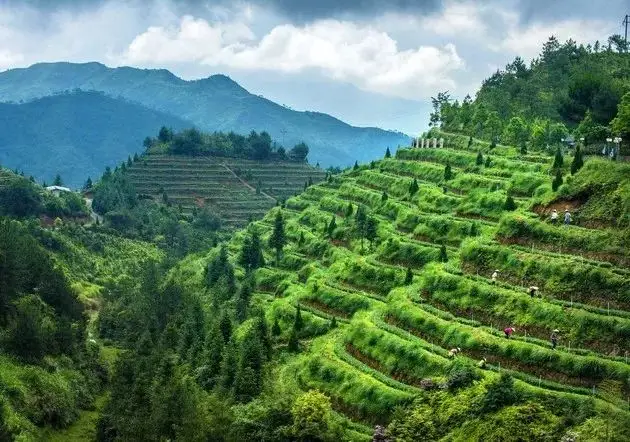
Gao Shan Tea Garden
Show Full Description
About Oolong Tea
Oolong Tea(Wu-lung tea,烏龍茶, dark dragontea), also known as "Qing Cha (Celadon tea)", is a traditional semi-oxidized Chinese tea. It adopts part of the processing technology of green tea and the fermentation technology of black tea. It is a semi-fermented tea between green tea and black tea. It has many varieties and is one of the Chinese Six Major Tea types.
The processing methods of Oolong tea involves picking fresh leaves, withering, rolling, Zuoqing, stir fixation (frying green), rolling, firing/baking. These steps may vary in different kinds of oolong tea.
Oolong tea evolved from royal tea "Dragon-Phoenix Tea Cake'in the Song Dynasty (960-1279) and came out around 1725 (The Reign of Emperor Yongzheng in the Qing Dynasty). Oolong tea maintains the characteristics of green tea and black tea.
The manufacture of Oolong tea involves repeating stages to achieve the desired amount of bruising and browning of leaves. Withering, rolling, shaping and firing are similar to those of black tea, but more attention should be paid to timing and temperature.
Beiyuan (北苑茶) tea is the earliest royal tea kind in Fujian, and also the most famous tea after the Song Dynasty. There are more than ten kinds of tea works on tea making and brewing in Beiyuan area in history. Beiyuan was located in the area around Fenghuang Mountain in Jianou, Fujian province, where tea production could be traced back to the late Tang Dynasty(618 to 907).
Legend And Origin
The most important product among Beiyuan teas is Dragon-Phoenix Tea Cake. Historical documents show that people at that time had to pick a basket of fresh leaves to make a Dragon-Phoenix Tea Cake. Tea pickers often carry baskets full of fresh tea and bump along the mountain road to the place where tea is processed. It was usually dark when they arrived at the designated place. The leaves that have just been picked are tightly piled together and sway during walking, and the injured fresh leaves will breathe and emit heat. Slowly, some leaves will turn purple or brown (influenced by enzymatic oxidation). This random process is actually a kind of semi-fermentation, which is similar to the fermentation technology of making oolong tea today. So to some extent, Beiyuan Tea is the predecessor of Oolong Tea. Around 1725, some tea farmers in Anxi region invented oolong tea inspired by the tea making methods in Wuyishan region. In 1862, there appeared some tea shops specialized in selling oolong tea in Fuzhou, Fujian. In 1866, oolong tea made in Taiwan Province appeared in foreign markets. Now the largest oolong tea producing area in China is Anxi County, Fujian Province. In 1995, it was named as "the hometown of oolong tea" by the Ministry of Agriculture and China Agricultural Association.

The Pattern Of Dragon-Phoenix Tea Cake Recorded In Ancient Book
Most oolong teas, especially those with high quality, have unique varieties of tea trees, which are specially
used in specific varieties. The degree of oxidation, which varies according to the chosen duration of time
before firing, can range from 8 to 85%, depending on the variety and production style.
Characteristics of Oolong tea
Oolong tea is characterized by a tightly twisted appearance, resembling dragonfly head, or being spherical or hemispherical. Most oolong teas, especially some high-quality oolong teas, are named after the varieties of tea. Some varieties of tea trees are specially used to make certain oolong tea. The oxidation degree of oolong tea varies according to the length of time before roasting, tea varieties and production methods, and is between 10% and 70. The color of oolong tea varies greatly from place to place.For example, some Guangdong oolong teas are yellowish brown, some Taiwan Oolong teas are verdant green, and some Fujian Oolong teas are glossy jade, dark-green or emerald. Processing methods (such as the degree of fermentation or the amount of time spent roasting in a charcoal fire) can also change color of dry tea as well as tea soup.
The fermentation degree of oolong tea has a certain influence on its aroma, taste and mouthfeel. Like the color, the aroma and taste of oolong tea are directly related to the tree species, the time it was picked, the processing skills and brewing method. In other words, each kind of oolong tea has its own unique taste. Most oolong teas have strong floral, fruity and sweet flavors. People who love tea can choose oolong tea according to their personal preferences.
Classification Of Oolong Tea Based On Fermentation Degree
On the basis of fermentation, Oolong tea can be divided into slightly fermented tea (about 10% - 25%),
moderately
fermented tea (about 25% - 50%) and severely fermented tea (about 50% - 70%).
Different fermentation levels and production methods have a direct impact on the characteristics of finished Oolong tea. Taking aroma as an example, mildly fermented Oolong tea resembles green tea and has a clear fragrance (清香). Moderately fermented Oolong tea has strong fragrance. Heavily fermented type is similar to black tea with a honey aroma.
Fujian Oolong Tea
Oolong tea is mainly produced in three provinces in China: Fujian, Guangdong and Taiwan.As Tieguanyin is mainly produced in Fujian Province, some information about Fujian oolong tea will be introduced next.
The appearance of Oolong tea in southern Fujian and Northern Fujian are different.There are two different distinct styles. The shape of Oolong teas in southern Fujian are rolled into long curly leaves, while that in Northern Fujian are 'wrap-curled' into small beads (Dragonfly head), each with a tail resembling frog leg. The taste of Fujian oolong tea has a lot to do with the variety of tea tree and the way it is processed.In terms of the taste of Fujian oolong tea, though complicated,it can be generally divided into three types, each can be subdivided into several smaller categories. Most of them have a very strong floral scent (such as orchid fragrance and gardenia fragrance,etc).
Origin of the name of Oolong tea
In fujianese dialect, "oolong" means "confused ". Why is a very good tea called "confused" tea? The legend says
the invention process of oolong tea is related to an old tea farmer who one day went home along the rugged
mountain road on his back carrying a basket filled with freshly picked tea leaves. Perhaps he was too old
and the mountain was too rough. He walked slowly, and the tea leaves on his back bumped and rubbed against each
other as his body leaned involuntarily , resulting in a flower-like fragrance emitting from the basket.The tea
farmer did not know how to explain this strange phenomenon, so he called the tea "Oolong tea (confused tea)" and
later ‘Oolong tea’ became the common name for this kind of tea.
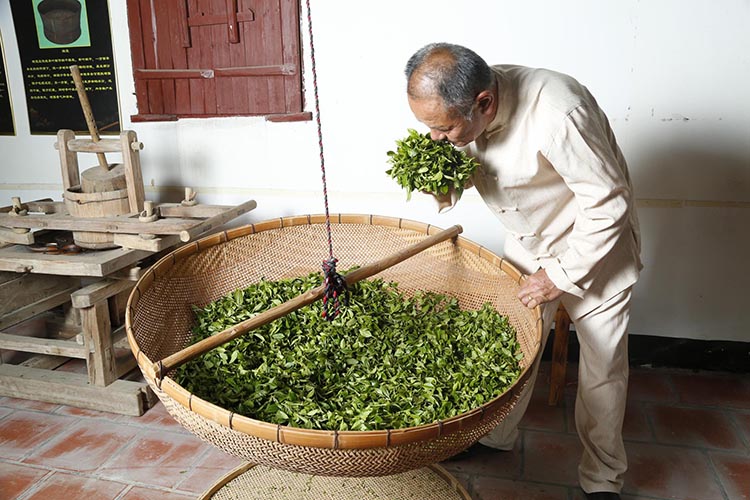
The Tossing And Cooling Skills Of Processing Tie Guan Yin
There is, of course, no proven basis for this legend. The processing technology of a new tea is the result of
numerous attempts, experiments and improvements. However, this story does make people remember the special
"摇青(Literally means shaking green tea leaves)" processing skill of Oolong tea, and also knows that the aroma of
Tie Guan Yin and Da Hong Pao comes from the key process of "摇青(shaking green tea leaves)".
Production area
Oolong tea originated in Fujian and spread from Fujian to Taiwan and Guangdong. So far, the main producing areas of Oolong tea are distributed in Fujian, Guangdong and Taiwan.
Processing Of Oolong Tea
Step 1: Harvesting When tea buds of Oolong tea grows to half the size of fully grown leaf (开面采), at that time tea leaves of Oolong tea are plucked or harvested.
Step 2: Withering Freshly picked leaves are dried under sun to remove moisture, as the moisture level determines the time taken for tea polyphenols to oxidise.
Step 3: Bruising It is a continuation of the withering process . This process further removes moisture and grassiness. Tea makers shake the tea leaves in a basket and put pressure on it through hand. The tea leaves are then spread out.
Step 4: Fixation The tea leaves are then heated to stop the oxidation process and to kill the enzymes.
Step 5: Rolling The tea leaves are then rolled by handpressing to the desired shape.
Step 6: Baking Oolong tea is then heated slowly at low temperature for an extended period of time. This extended heating process is the reason for lasting after many infusions as compared to green tea.
Step 7: Sorting and Packaging Sub standard tea leaves are removed and good ones are packed.
Some of the above steps are repeated several times to achieve the desired amount of bruising and browning of leaves with much more attention to timing and temperature is necessary.
About Tie Guan Yin
Tie Guan Yin tea, a famous traditional Chinese Oolong tea, is one of the top-ten famous teas in China. It originated from Xiping Town, Anxi County, Quanzhou City, Fujian Province and was created in 1723-1735. "Tie Guan Yin" is not only the name of tea, but also the name of tea plant varieties.
The tea is named after the Chinese Goddess of Mercy Guanyin. Another name for Guanshiyin is Guanshiyin, the most popular female Buddha in China. Chinese Buddhism believes that Guanyin is the most kind-hearted and helpful omnipotent woman in the world. As long as the person in trouble reads the names, Guanyin will follow the sound to save. The word Tie means' iron '. The dry tea leaves of Tie Guan Yin are much heavier than other Chinese tea. In China, people use "as heavy as iron" to describe it. The word "Guanyin" means listening to people's suffering. Tieguanyin is directly expressed as "Iron Buddha", "Iron Goddess Oolong" or "Tea of the Iron Bodhisattva" in English. The tea trees that produces' Tieguanyin "is a delicate plant, which is vulnerable to the harsh environment, and its yield is low. This is why there is a saying that "Tie Guan Yin tea is good to drink but not easy to plant".
Producing areas of Tie Guan Yin Tea
Tie Guan Yin is mainly produced in four regions:
1.Xiping Producing Area
Xiping Town, Anxi County, Fujian Province, is the birthplace of Tie Guan Yin and a paradise for oolong tea. This small town has a history of planting iron Guanyin for more than 300 years and most of the Tie Guan Yin produced in this town are made using traditional methods.
2.Longjuan Producing Area
Producing areas of Longjuan tea include Longjuan Township in Anxi County and its nearby areas.
Longjuan Producing areas include Longjuan Town, Luoyan and Huqiu in Fujian province. Tie Guan Yin produced in this area is characterized by high tightness, heavy body, appearance with lustre and strong aroma. Although the quality of oolong tea from this area is not the best, it is very popular due to its high cost performance.
3.Gan De Producing Area
Gan De Producing area includes Gan De town, Jian Dou town, Taozhou town, Hushang town and other places in Anxi County.Gan De oolong teas feature vibrant full-bodied aroma,slight sour taste.
4. XiangHua Producing area
XiangHua Producing area includes Xianghua Town, Changkeng Town and other nearby areas in Anxi County. Generally speaking, the Tie Guan Yin produced here is of high quality because it grows in high mountains and influenced by the good climate conditions. Most high-grade Tie Guan Yin are mainly produced here.
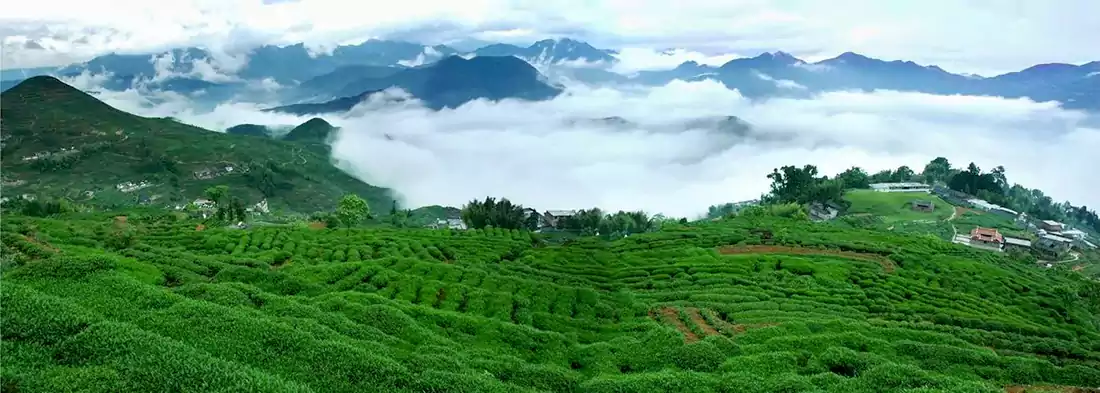
Anxi Tieguanyin Tea Garden
Processing Steps Of Tie Guan Yin
1.Plucking Fresh Leaves
When the new shoots of the tea plant have reached three to five leaves that are about to mature.
1. Xiao Kai Mian: 2-4 tea leaves under the terminal buds are picked or harvested when the leaf buds of Oolong tea grow to the size of half the mature leaves.
2.Zhong Kai Mian: 2-4 tea leaves under the terminal buds are picked or harvested when the leaf buds of Oolong tea grow to the 2/3 size of the mature leaves.
3.Da Kai Mian: 2-4 tea leaves under the terminal buds are picked or harvested when the leaf buds of Oolong tea grow to about the same size as mature leaves.
Kai Mian: Used to describe how wide leaves of a bud unfold, the wider the bud leaves opens the mature it will be.
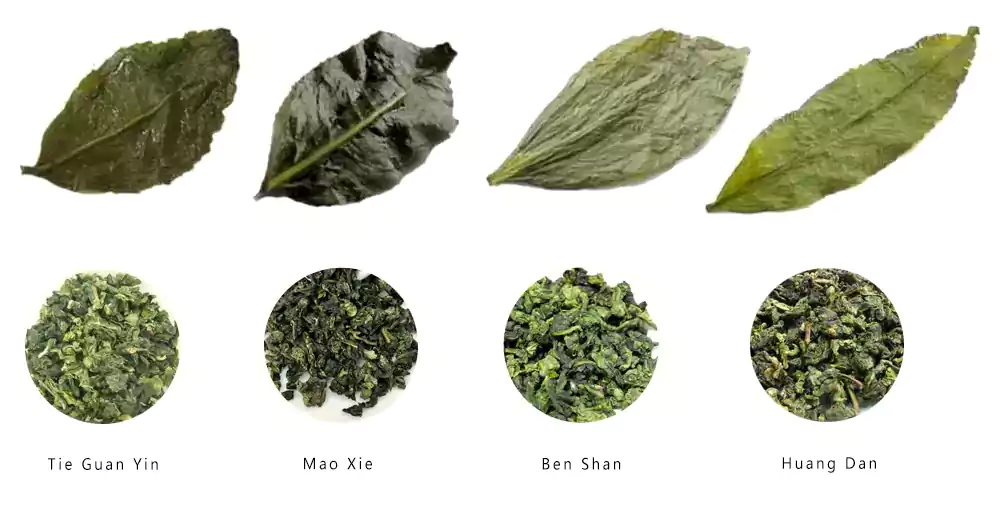
Comparison Of Several Kinds Of Oolong Teas
In general, the leaves for making Tie Guan Yin should not be too old or too tender, and the leaf size should not vary too much.
Tie Guan Yin has four or five harvesting seasons a year, depending on the growing state of the tea plants. Generally speaking, Oolong tea made in spring and autumn is of good quality.
2. Withering
This process includes two steps: drying under the sun or using artificial heat and cooling. The main purpose is to adjust the water content and accelerate the enzymatic reaction.
3. Zuo Qing
This step is unique to making oolong tea.It includes two repeating steps: tossing and cooling. Zuo Qing is the key technology for making Tieguanyin. It can dramatically change the biochemical composition of green leaves. At the same time, the shape, color and smell of leaves have changed significantly.
4. Rolling
The tea leaves are then made by hand into the desired shape according to the requirements of the finished product.
4.Stir Fixation(Frying Green)
The principle of Stir fixation tea is basically the same as that of green tea. That is, by using high temperature, the activity of polyphenol oxidase of tea leaves is destroyed in a relatively short time and the enzymatic oxidation is stopped, so as to prevent the continued oxidation of green leaves and consolidate the quality of green leaves undergong Zuo Qing step.
6.Baking
Baking is an important process for stabilizing, improving and forming Oolong tea quality. Baking can make the water evaporate continuously, thus fixing the appearance, aroma,taste formed before baking, stabilizing the inner quality,making final tea can be stored for a long time without deterioration. With the heat, the effective components in tea can be transformed, so as to improve the taste and enhance the expression of color and aroma of tea soup.
7.Sorting And Packaging
According to the quality standards, the unqualified parts are removed, and the remaining tea leaves are packaged and sold in grades.

Tie Guan Yin Tea Plant
Characteristics Of Tie Guan Yin Tea
The high-quality Tieguanyin leaves are curly, tightly twisted, heavy and strong, like dragonfly with a tail (resembles frog’s leg). When brewing,gives off fragrance like orchid aroma mixed with various fresh scents. Some people describe it as having a coconut, milk, honey smell or other aroma, but it's very unique and it varies from person to person.
| Chinese Gongfu Method | |
| Tea | 3g |
| Water | Gaiwan 3oz / 90ml |
| Time | 5 steeps (25s,40s,1m30s,2m,3m) |
| Temperature | 90°c |
| Teapot Method | |
| Tea | 5g |
| Water | Teapot (8oz / 240ml) |
| Time | 1- 4mins |
| Temperature | 90°c |


